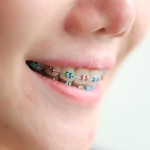
Enamel white spot lesions are a potential side-effect of multi-bracketed fixed orthodontic treatment with more than half of orthodontic patients developing at least 1 lesion. Some studies reporting that prevalence may be as high as 73.5% when appliances are debonded.
The aim of this review was to assess the effectiveness of self-applied topical fluorides in the prevention and reversal of enamel white spot lesions (EWSLs) occurring during multi-bracketed fixed orthodontic treatment.
Methods
Searches were conducted in the Medline, Embase, Cochrane Library and Scopus databases.Randomised controlled trials (RCTs) or quasi-RCTs involving self-applied topical fluorides applications (toothpastes, rinses or gels) for patients undergoing fixed appliance orthodontic treatment for the prevention of EWSLs were considered. Only English language publications were included. Two reviewers independently selected studies extracted data and assessed risk of bias using the Cochrane tool. Quantitative analysis was planned to follow the Cochrane handbook. However due to a limited number of studies and use of different outcome measurements only a qualitative summary was provided.
Results
- 3 RCTs involving a total of 531 patients were included.
- 1 study was considered to be at low risk of bias and 2 studies at high risk.
- 2 studies assessed prevention of EWSLs from the start of orthodontic treatment to debonding. One study comparing high and low concentration toothpaste, the other comparing 250 ppm fluoride rinse (150 ppm NaF and 100 ppm amine fluoride) to the placebo rinse. Both studies found fewer EWLs in the group receiving the higher concentration of fluoride.
- 1 study assessed reversal of post-orthodontic EWSLs over 26 weeks finding no difference between a low sodium fluoride mouth rinse (50 ppm) and placebo rinse.
Conclusions
The authors concluded: –
Although the review did not confirm the effectiveness of self-applied fluorides in the reversal of EWSLs, it did partially substantiate the positive role of self-applied fluorides in the prevention of EWSLs occurring during multi-bracketed fixed orthodontic treatment. The review recommends the need for well-designed randomized controlled trials evaluating the effectiveness of self-applied fluorides on the prevention and reversal of EWSLs during multi-bracketed fixed orthodontic treatment.
Comments
The reviewers have searched 4 databases and used a protocol which was registered on the PROSPERO database. However, they did restrict the included studies to those published in English which has the potential to exclude some studies. The authors do note in their discussion that the 2012 study by Morrison et al found no-evidence of systematic bias from the use of language restrictions in systematic reviews in conventional medicine and might hold true for dentistry. This review found only 3 studies with a suggestion of benefit from self-application of higher fluoride products. The same group also reported on professionally applied topical fluorides during fixed appliance treatment (Dental Elf – 25th Feb 2019) reporting a 25–30% reduction in the incidence of EWSLs after debonding.
Links
Primary Paper
Sardana D, Manchanda S, Ekambaram M, Yang Y, McGrath CP, Yiu CKY. Effectiveness of self-applied topical fluorides against enamel white spot lesions from multi-bracketed fixed orthodontic treatment: a systematic review. Eur JOrthod. 2019 Apr 9. pii: cjz015. doi: 10.1093/ejo/cjz015. [Epub ahead of print]PubMed PMID: 31112229.
Other references
Dental Elf – 25th Feb 2019
Fluoride for white spot lesion prevention during orthodontic treatment
Morrison A, Polisena J, Husereau D, Moulton K, Clark M, Fiander M, Mierzwinski-Urban M, Clifford T, Hutton B, Rabb D. The effect of English-language restriction on systematic review-based meta-analyses: a systematic review of empirical studies. Int J Technol Assess Health Care. 2012 Apr;28(2):138-44. doi: 10.1017/S0266462312000086. Review. PubMed PMID: 22559755.
